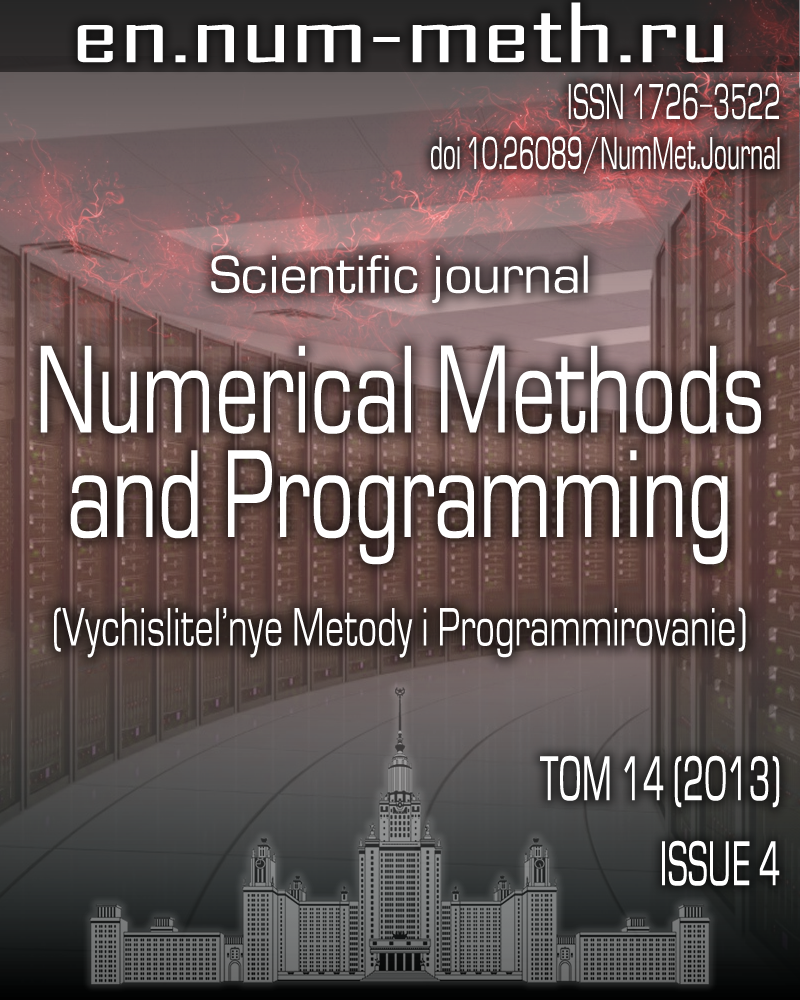Acceleration of molecular dynamics simulations using the fast multipole method and graphics processing units
Keywords:
Abstract
This work contains the speed-up results for the molecular dynamics simulations of electrostatic potentials in the application to water molecules. High-performance computations are achieved via the fast multipole method (FMM) for force calculation and the use of heterogeneous architectures, consisting of central and graphics processing units (CPU and GPU, respectively). FMM allows one to speed up the calculations of the far-field interactions by reducing the computational complexity from square complexity to the linear one. The use of the GPUs allows one to significantly speed up the computations. The realization of the FMM on GPU provides an opportunity to implement the computation experiments for large data sets. This paper shows that the method described has a great scalability and can be used to simulate the water dynamics for domains of 60 nm or for the number of molecules of over 10 million on personal workstations equipped with a single GPU.
Published
Issue
Section
References
- Haile J.M. Molecular dynamics simulation: elementary methods. New York: Wiley publication, 1992.
- Allen M.P. Introduction to molecular dynamics simulation // Computational Soft Matter: From Synthetic Polymers to Proteins. Lecture Notes. Vol. 23. Jülich: Neumann Inst. for Computing, 2004. 1-28.
- Maruyama S., Kimura T. A molecular dynamics simulation of a bubble nucleation on solid surface // Int. J. of Heat &; Technology. 2000. 18. 69-74.
- Maruyama S. Molecular dynamics method for microscale heat transfer // Adv. Numer. Heat Transfer. 2000. 2. 189-226.
- Anderson J.A., Lorenz C.D., Travesset A. General purpose molecular dynamics simulations fully implemented on graphics processing units // J. of Computational Physics. 2008. 227, N 10. 5342-5359.
- Sunarso A., Tsuji T., Chono S. GPU-accelerated molecular dynamics simulation for study of liquid crystalline flows // J. of Computational Physics. 2010. 229, N 15. 5486-5497.
- Nyland L., Harris M., Prins J. Fast N-body simulation with CUDA //
- Darden T., York D., Pedersen L. Particle mesh Ewald: an extitNlog extitN method for Ewald sums in large systems // J. of Computational Physics. 1993. 98, N 12. 10089-10092.
- Lindbo D., Tornberg A.-K. Fast and spectrally accurate Ewald summation for 2-periodic electrostatic systems // J. Chem. Phys. 2012. 136. 164111.
- Luty B.A., van Gunsteren W.F. Calculating electrostatic interactions using the Particle-Particle Particle-Mesh method with nonperiodic long-range interactions // J. Phys. Chem. 1996. 100, N 7. 2581-2587.
- Bossis G. Molecular dynamics calculation of the dielectric constant without periodic boundary conditions // Molecular Physics: An International Journal at the Interface Between Chemistry and Physics. 1979. 38. 2023-2035.
- Barnes J., Hut P. A hierarchical extitO(Nlog extitN) force-calculation algorithm // Nature. 1986. 324. 446-449.
- Greengard L., Rokhlin V. A fast algorithm for particle simulations // J. of Computational Physics. 1987. 73, N 2. 325-348.
- Gumerov N.A., Duraiswami R. Fast multipole methods on graphics processors // J. of Computational Physics. 2008. 227. 8290-8313.
- Hu Q., Gumerov N.A., Duraiswami R. Scalable fast multipole methods on distributed heterogeneous architectures // Proc. of 2011 Int. Conf. for High Performance Computing, Networking, Storage and Analysis. New York: ACM Press, 2011. Article N 36.
- Rapaport D.C. The art of molecular dynamics simulation. Cambridge: Cambridge Univ. Press, 2004.
- Frenkel D., Smit B. Understanding molecular simulation. New York: Academic, 2002.
- Barker J., Watts R. Structure of water: a Monte Carlo calculation // Chemical Physics Letters. 1969. N 3. 144-145.
- Rahman A., Stillinger F.H. Molecular Dynamics Study of Liquid Water // J. of Chemical Physics. 1971. 55. 3336-3360.
- Jorgensen W.L., Chandrasekhar J., Madura J.D., Impey R.W., Klein M.L. Comparison of simple potential functions for simulating liquid water // J. of Chemical Physics. 1983. 79. 926-935.
- Martin J.F. A practical introduction to the simulation of molecular systems. Cambridge: Cambridge Univ. Press, 2007.
- Зацепина Г. Свойства и структура воды. М.: Изд-во Моск. ун-та, 1974.
- Soper A., Phillips M.G. A new determination of the structure of water at 25^circС // J. of Chemical Physics. 1986. 107. 47-60.
- Dongarra J., Sullivan F. Guest editor’s introduction: the top 10 algorithms // Computing in Science and Engineering. 2000. 2, N 1. 22-23.
- Gumerov N.A., Duraiswami R., Borovikov E.A. Data structures, optimal choice of parameters, and complexity results for generalized multilevel fast multipole methods in d dimensions // Technical Report CS-TR-4458. College Park: Univ. of Maryland, 2003.
- Harris M., Sengupta S., Owens J.D. Parallel prefix sum (scan) with CUDA // GPU Gems 3. Boston: Addison Wesley, 2007. 851-876.
- Morton G.M., Phillips M.G. A computer oriented geodetic database and a new technique in file sequencing // IBM Technical Report. Ottawa, 1966.
- Hu Q., Gumerov N.A., Duraiswami R. Scalable distributed fast multipole methods // Proc. of 14th IEEE International Conference on High Performance and Communications (HPCC-2012). New York: IEEE Press, 2012. 270-279.
- Yokota R., Barba L. Treecode and fast multipole method for N-body simulation with CUDA // GPU Computing Gems. Emerald Edition. Boston: Elsevier and Morgan Kaufmann, 2011. 113-132.
- NVIDIA CUDA Compute Unified Device Architecture Programming Guide. Version 5.0. 2012.
- http://lammps.sandia.gov


